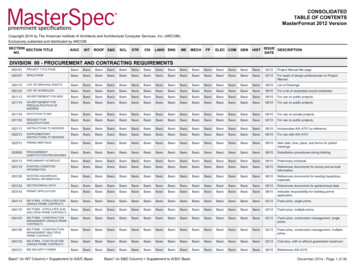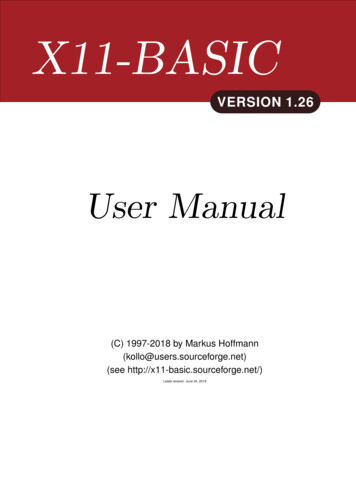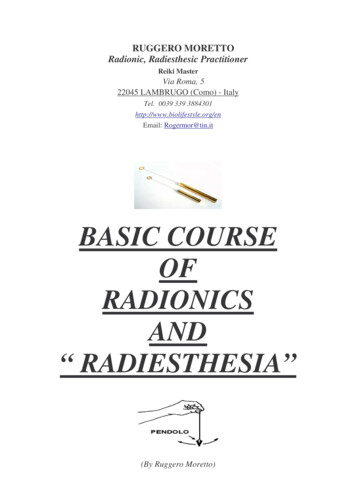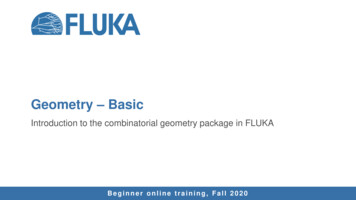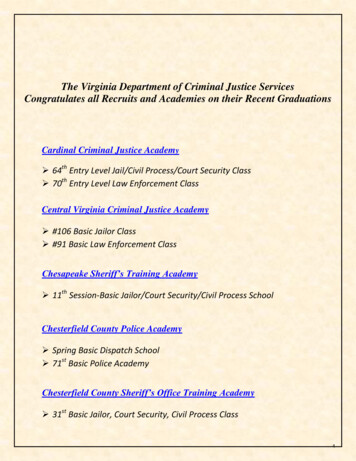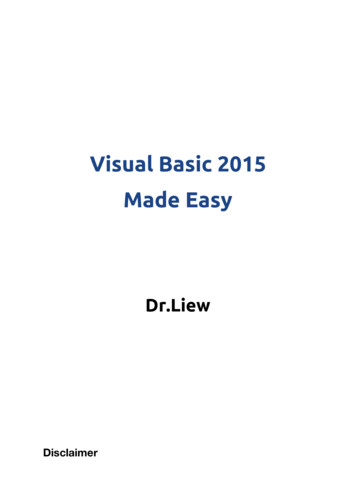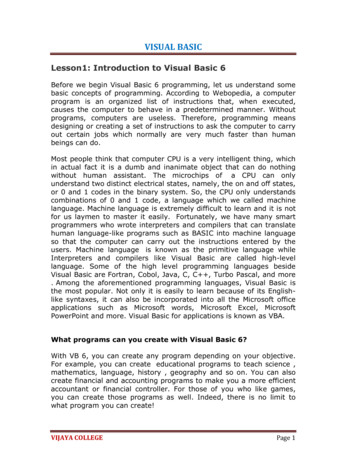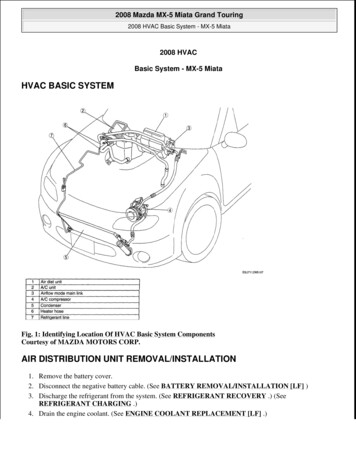
Transcription
BasicPipe Stress AnalysisTutorialVisit our website — www.sstusa.comSST Systems, Inc.
SST Basic Pipe Stress Analysis Tutorial, Version 1.00, 2011 - 2014, SST Systems, Inc. AllRights Reserved.DisclaimerPlease read the following carefully:CAEPIPE and this tutorial have been developed and checked for correctness and accuracyby SST Systems, Inc. However, no warranty, expressed or implied, is made by the authors orby SST Systems, Inc., as to the accuracy and correctness of the tutorial or the functioning ofCAEPIPE and the accuracy, correctness and utilization of its calculations. Users must carryout all necessary tests to verify CAEPIPE calculations, and the applicability of their results.All information presented by CAEPIPE is for review, interpretation, approval andapplication by a Registered Professional Engineer.CAEPIPE is a trademark of SST Systems, Inc. All other product names mentioned in thisdocument are trademarks or registered trademarks of their respective companies/holders.SST Systems, Inc.1798 Technology Drive, Ste. 236San Jose, CA 95110, USATel: (408) 452 8111Fax: (408) 452 8388info@sstusa.comwww.sstusa.com
Basic Pipe Stress Analysis TutorialGood, relevant and non-overwhelming technical information on pipe stress analysis is hard to come by. So, we decided to provide a simpletutorial on the basics of piping stress analysis. This tutorial is directed towards newcomers to Pipe Stress Analysis just as much as toengineers new to CAEPIPE.To get the full benefit from this tutorial, you will need a working copy of CAEPIPE, pipe stress analysis software.Download a Free Copy of CAEPIPE hereCAEPIPE - Features and BenefitsUseful learning resources:CAEPIPE Tutorial 1CAEPIPE Tutorial 2CAEPIPE Users ManualPipe Stress Tips ArchiveThe Piping Journal BlogYou are welcome to use any other program if you choose to.Tutorial: Table of ContentsA Technical Article on the Basic ConceptsA Preliminary Pipe Stress Analysis ProcedureFive simple, illustrative examples, four of which build upon the previous onesExample 1 - Using Expansion LoopsExample 2 - Splitting Thermal GrowthExample 3 - Axial Restraints to Direct Thermal GrowthExample 4 - Locating Supports For Deadweight AnalysisExample 5 – Making Layout Changes to Reduce Thermal StressesPipe Stress Analysis: Basic ConceptsIntroductionIt is common practice worldwide for piping designers to route piping by considering mainly space, process and flow constraints (such aspressure drop) and other requirements arising from constructability, operability and reparability. Unfortunately, pipe stress analysisrequirements are often not sufficiently considered while routing and supporting piping systems, especially in providing adequate flexibility toabsorb expansion/contraction of pipes due to thermal loads. So, when “as designed” piping systems are handed-off to pipe stress engineersfor detailed analysis, they soon realize that the systems are “stiff” and suggest routing changes to make the systems more flexible. Thepiping designers, in turn, make changes to routing and send the revised layout to the pipe stress engineers to check for compliance again.Such “back and forth” design iterations between layout and stress departments continue until a suitable layout and support scheme is arrivedat, resulting in significant increase in project execution time, which, in turn, increases project costs.This delay in project execution is further worsened in recent years by increased operating pressures and temperatures in order to increaseplant output; increased operating pressures increase pipe wall thicknesses, which, in turn, increase piping stiffnesses further. Such increasedoperating temperatures applied on “stiffer” systems increase pipe thermal stresses and support loads. So, it is all the more important to makethe piping layout flexible at the time of routing. (CheckStress, SST’s add-on product for PDMS and Cadmatic directly addresses and solvesthis problem).SST Systems, Inc.1
Types of LoadsPiping systems experience different types of loadings, categorized into three basic loading types — Sustained, Thermal and Occasionalloads.Sustained LoadsThese mainly consist of internal pressure and dead-weight. Dead-weight is from the weight of pipes, fittings, components such as valves,operating fluid or test fluid, insulation, cladding, lining etc.Internal design or operating pressure causes uniform circumferential stresses in the pipe wall, based on which a pipe wall thickness isdetermined during the process/P&ID stage of plant design. Additionally, internal pressure gives rise to axial stresses in the pipe wall. Sincethese axial pressure stresses vary only with pressure, pipe diameter and wall thickness (all three of which are preset at the P&ID stage),these stresses cannot be altered by changing the piping layout or the support scheme.A pipe’s deadweight causes it to bend (generally downward) between supports and nozzles, producing axial stresses in the pipe wall (alsocalled “bending stresses”) which vary linearly across the pipe cross-section, being tensile at either the top or bottom surface andcompressive at the other surface. If the piping system is not supported in the vertical direction (i.e., in the gravity direction) exceptingequipment nozzles, bending of the pipe due to deadweight may develop excessive stresses in the pipe and impose large loads on equipmentnozzles, thereby increasing its susceptibility to “failure by collapse.”Various international piping standards/codes impose stress limits, also called “allowable stresses for sustained loads,” on these axialstresses generated by deadweight and pressure in order to avoid “failure by collapse.”For the calculated actual stresses to be below such allowable stresses for sustained loads, it may be necessary to support the piping systemvertically. Typical vertical supports to carry deadweight are:ƒƒƒƒVariable spring hangersConstant support hangersRod hangersResting steel supports.Rod hangers and resting steel supports fully restrain downward pipe movement but permit pipe to lift up.A couple of examples are presented in this tutorial to illustrate how piping can be supported by spring hangers and resting steel supports tocomply with the code requirements for sustained loads.Thermal Loads (Expansion Loads)These refer to the “cyclic” thermal expansion or contraction of piping as it goes from one thermal state to another (for example, from “shutdown” to “normal operation” and then back to “shut-down”). If the piping system is not restrained in the thermal growth/contraction directions(for example, in the axial direction of pipe), then, for such cyclic thermal load, the pipe expands/contracts freely; in this case, no internalforces, moments and resulting stresses and strains are generated in the piping system. If, on the other hand, the pipe is “restrained” in thedirections it wants to thermally deform (such as at equipment nozzles and pipe supports), such constraint on free thermal deformationgenerates cyclic thermal stresses and strains throughout the system as the system goes from one thermal state to another. When suchcalculated thermal stress ranges exceed the “allowable thermal stress range” specified by various international piping standards/codes, thenthe system is susceptible to “failure by fatigue.” So, in order to avoid “fatigue” failure due to cyclic thermal loads, the piping system should bemade flexible (and not stiff).SST Systems, Inc.2
This is normally accomplished as follows:a) Introduce bends/elbows in the layout, as bends/ elbows “ovalize” when bent by end‐moments, which increases piping flexibility.b) Introduce as much “offset” as possible between equipment nozzles (which are normallymodeled as anchors in pipe stress analyses).For example, if two equipment nozzles (which are to be connected by piping) are in line,then the straight pipe connecting these nozzles will be “very stiff”. If, on the otherhand, the two equipment are located with an “offset,” then their nozzles will have to beconnected by an “L‐shaped” pipeline which includes a bend/elbow; such “L‐shaped” pipelineis much more flexible than the straight pipeline mentioned above.c) Introduce expansion loops (withabsorb thermal growth/contraction.each loopconsisting of fourbends/elbows) tod) Lastly, introduce expansion joints such as bellows, slip joints etc, if warranted.In addition to generating thermal stress ranges in the piping system, cyclic thermal loads impose loads on static and rotating equipmentnozzles. By following one or more of the steps from (a) to (d) given above and steps (e) and (f) given below, such nozzle loads can bereduced.e) Introduce “axial restraints” (which restrain pipe in its axial direction) atappropriate locations such that thermal growth/contraction is directed away from nozzles.f) Introduce “intermediate anchors” (which restrain pipe movement in the threetranslational and three rotational directions) at appropriate locations such that thermaldeformation is absorbed by regions (such as expansion loops) away from equipment nozzles.A few example layouts are presented to illustrate how loops/offsets, axial restraints and intermediate anchors are used to reduce thermalstresses in piping (and resulting nozzle loads).Occasional LoadsThis third type of loads is imposed on piping systems by occasional events such as earthquake, wind or a fluid hammer. To protect pipingfrom wind and/or earthquake (which normally occur in a horizontal plane), it is normal practice to attach “lateral supports” to piping systems(instead of “axial restraints”). On the other hand, to protect piping for water/steam hammer loads, both “lateral supports” and “axial restraints”may be required.To carry sustained loads, normally vertical supports are required. For thermal loads, having no supports gives zero stresses. So, fewer the numberof supports, lower the thermal stresses. Axial restraints and intermediate anchors are recommended only to direct thermal growth away fromequipment nozzles.SST Systems, Inc.3
Pipe Stress Analysis: Preliminary ProcedureModel the piping system in CAEPIPE (either directly inside CAEPIPE, or by using one of SST’s data translators to import the piping model)and follow the steps shown in the CAEPIPE Tutorial to learn the basics of operating CAEPIPE to create and analyze a model and review itsresults. Once all the data is in, Analyze. Now, review Results.General ProcedureFrom the thermal stress contour plot and the deflected shape for thermal load case, suitably route the pipe to make it more flexible andposition axial restraints and/or intermediate anchors, if required, to direct thermal expansion/contraction away from critical locations such asequipment nozzles. Similarly, decide the types and locations of vertical supports based on the stress contour plot and deflected shape forsustained ( weight pressure) load case as well as the deflected shape for operating load case ( sustained load thermal load).Here is a step-by-step procedureStep 1Review the thermal stress contour plot first. The plot is color-coded such that “blue” region denotes areas with the least stress ratios (wherestress ratio equals to actual computed stress divided by material allowable stress), “green” region with higher stress ratios, “yellow” regionwith even higher stress ratios, and “red” region with the highest stress ratios. Intermediate areas between these distinct colors will be of“bluish-green”, “greenish-yellow” and “orange” colors.The goal will be to arrive at a layout that avoids “orange” and “red” zones in thermal stress plot so that there is sufficient thermal margin leftfor performing a detailed piping analysis when the layout is finalized at the 3D-design stage. You may wish to avoid even the “yellow” zone inthe stress contour plot so as to provide additional thermal margin for future use. Since thermal stresses generated are directly dependent onhow “stiff” or “flexible” the layout is, in order to reduce thermal stresses, it may be necessary to make the layout “flexible” (by including bends,offsets, loops etc.). So, the first step is to make sure thermal stress ratios remain within “blue to yellow” range and not get into “orange” and“red” zones. For more “flexible” layout, even “yellow” zone can be avoided.Step 2In case thermal stress ratios exceed “yellow” zone (and are in “orange” and “red” zones in one or more areas of the piping system), it isimportant to study the thermal case deformed shape provided by CAEPIPE in order to understand how the piping responds to “pure thermal”load. By studying such deformed shape, it is possible to arrive at a layout with appropriate bends, offsets and loops and/or with appropriatelylocated axial restraints/intermediate anchors such that thermal stress ratios do not exceed “yellow” zone. This process may require you toperform several layout and/or restraint scheme iterations.Step 3After finalizing piping layout under Steps 1 and 2 for thermal loading, the next task is to support the system vertically to carry its deadweightunder operating condition. In this connection, first review sustained stress ratio contour plot generated by deadweight and pressure for thesystem without any vertical supports excepting those provided by equipment nozzles, shown in color codes from “blue” to “green” to “yellow”to “red” (as in Step 2 above).Your goal is to arrive at a vertical support scheme consisting of(a) resting steel supports (b) rod hangers variable spring hangers and (d) constant support hangersat appropriate locations (where such pipe supports can be attached to adjacent concrete/steel structures, platforms etc.) so that stresscontour plot for sustained stress ratios avoids “orange” and “red” zones and remains within “blue to yellow” range.Step 4In case sustained stresses exceed “yellow” zone in one or more areas of the piping system, study the deformed shape for sustained loadcase in order to understand how the piping responds to its own deadweight: next, identify pipe locations in the 3D model where the pipe canbe vertically supported by the support types listed above. Based on this information, it is possible to vertically support the piping such thatsustained stresses do not exceed “yellow” zone. This step may require you to execute several iterations within CAEPIPE with several verticalsupport schemes.In case, resting steel supports are selected to provide vertical support for piping under sustained load, it is to be made sure that pipingcontinues to rest on such steel supports even during operating condition ( weight pressure thermal) and does not lift off from thesesupports. If pipe lifts up at any of these resting supports during operating condition, then that support does not carry any pipe weight andhence will not serve its purpose. Similarly, at rod hanger locations, the tendency of piping should be to deform downward for operating loadSST Systems, Inc.4
case, so that the rod hangers carry the pipe weight under tension. On the other hand, if pipe lifts up at any of the rod hangers, then that rodhanger goes into compression thereby not carrying the weight of the piping during operating condition.CAEPIPE displays the deflected shape of piping under operating load case too. By viewing this deflection from different directions, you canmake sure that piping is resting on steel supports and/or piping is not deforming upward at rod hangers.Step 5You should perform Steps 1 to 4 for all piping systems of the project. Systems, for which the layout and support schemes are finalized, areready for detailed analyses and stress report preparation.Verification StepProvide all additional input data into the models such as insulation thickness and density, corrosion allowance and mill tolerance of pipesections, thermal anchor movements, seismic anchor movements, support conditions such as friction and gap, other loads such as wind,seismic and water/fluid hammer, multiple thermal and pressure cases, etc. and perform detailed analyses. It is most likely that the layout andsupport schemes (finalized during steps 1–4) meet all other pipe stress requirements (such as meeting nozzle allowable loads) and hardlyrequire any further iteration(s).SST Systems, Inc.5
Example 1 - Using Expansion LoopsDATA: An 8” NB Schedule 80 pipe (see Fig. 1A) connects two equipment at nodes 10 and 30 with an offset of 4’ (i.e., equal to distancebetween nodes 20 and 30). The pipe, made of A53 Grade A carbon steel, is heated to 300 F.This problem illustrates the use of expansion loops to reduce thermal stresses.Figure 1A – LayoutAfter modeling this layout in CAEPIPE, upon analysis, you will find that the pipe between nodes 10 and 20 grows thermally to the righttowards node 20, while pipe between nodes 30 and 20 grows up towards node 20, as illustrated in Fig. 1B.Figure 1B - Thermal DeflectionThis thermal deformation generates large thermal stresses (orange and red zones) in the bend at node 20 and at anchor node 30, as shownin Fig. 1C.SST Systems, Inc.6
Figure 1C - Non code-compliant (notice the reds)The reds illustrate that the expansion stress is over the allowables, and fails code compliance. This layout will have to be rerouted. Let us trythe rerouting as shown in Fig.1D.Figure 1D - ReroutingFig. 1D shows a revised layout with a loop, introducing two additional bends at nodes 14 and 18, thereby making the layout more flexible. So,thermal growth of X-directional pipes between nodes 10 and 14 and then between 18 and 20 as well as the growth of Z-directional pipebetween nodes 30 and 20 are absorbed by the three bends at nodes 14, 18 and 20. The corresponding stress contour plots for thermal andsustained load cases are shown in Fig.1E and Fig. 1F, confirming code compliance.SST Systems, Inc.7
Figure 1E - Code-compliant thermal caseFigure 1F - Code-compliant sustained caseSST Systems, Inc.8
Example 2 - Splitting Thermal GrowthDATA: This system shown in Fig. 2A is made of three pipe sizes:ƒƒƒƒ4” NB/Sch. 40: Between nodes 10 and the first reducer6” NB/Sch. 40: Between the first reducer and the second reducer and ending at node 908” NB/Sch. 40: Between nodes 90 and anchor node 130T 470 FFigure 2A – LayoutSince the loop between nodes 10 and 40 is much more flexible (4” pipe) than the loop between nodes 100 and 130 (8” pipe), the straightpipe between nodes 40 and 100 will thermally grow mostly towards the 4” loop, as shown in Fig. 2B, straining the pipe between nodes 10and 40.Figure 2B - Thermal Deformation PlotSST Systems, Inc.9
This, in turn, produces large thermal stresses (i.e., orange and red zones) in the 4” loop and at anchor node 10, as observed in Fig. 2C. Inother words, the thermal growth of pipe between nodes 40 and 100 is mostly absorbed by the 4” loop and very little by the 8” loop, defeatingthe very purpose of the 8” loop.Figure 2C - Thermal Stress Contour PlotIn order to alleviate thermal stresses in the 4” loop, introduce an intermediate anchor at node 95 immediately after the second reducer, sothat the thermal growth of straight pipe from node 95 to node 100 is absorbed by the 8” loop, while the thermal expansion of straight pipebetween nodes 40 and 95 is absorbed by the 4” loop, thereby making both loops achieve their intended purpose. The corresponding thermaldisplacement and thermal stress contour plots are given in Fig. 2D and Fig. 2E respectively.Figure 2D - Thermal Deformation Plot for Layout with Intermediate AnchorSST Systems, Inc.10
Figure 2E - Thermal Stress Contour Plot for Layout with Intermediate AnchorFig. 2F confirms that the present configuration with only two equipment nozzles at nodes 10 and 130 and an intermediate anchor at node 95safely meets the code stress requirement for sustained load.Figure 2F - Sustained Stress Contour Plot for Layout with Intermediate AnchorSST Systems, Inc.11
Example 3 - Axial Restraints to Direct Thermal GrowthThis problem shows how axial restraints (i.e., pipe supports that prevent movement along a pipe’s axis) can be effectively used to directthermal growth towards expansion loops and split thermal growth in a line such that the two piping portions grow in opposite directions.Figure 3A - Layout with Intermediate Anchor at Node 95Fig. 3A shows the same problem as in Example 2 but with a 6” NB branch line added at the welding tee at node 70 (i.e., from node 70 tonode 240).The deformed geometry, due to the thermal load (Fig. 3B), shows that the tee at node 70 does not move up in Y-direction. The intermediateanchor at node 95 restrains the vertical riser (between nodes 220 and 70) from thermally growing upward towards node 70. As a result, thisriser grows downward producing large bending moments and stresses at and around equipment nozzle at node 240.Figure 3B - Thermal Deformation PlotSince the intermediate anchor effectively restrains upward growth of this vertical riser node 70, we see large localized thermal stress at thewelding tee. See thermal stress contour plot shown in Fig. 3C.SST Systems, Inc.12
Figure 3C - Thermal Stress Contour PlotFigure 3D - Layout with Axial Restraints at Node 95 and 210Fig. 3D shows the same piping system with one axial restraint at 95 (replacing the intermediate anchor at node 95) and another at node 210— the one at node 95 splits and directs thermal growth towards the 4” and 8” loops and permits the horizontal line to move up in Y-directionat node 70; the second one at node 210 splits the thermal growth of the vertical riser (between nodes 220 and 70). The resulting deformedgeometry plot in Fig. 3E shows a more flexible system, which produces smaller forces and moments, and hence stresses at the equipmentnozzle node 240 and welding tee node 70.SST Systems, Inc.13
Figure 3E - Thermal Deformation Plot for Layout with Axial RestraintsFigures 3F and 3G show the thermal and sustained stress contour plots (in this case sustained stress is due to only deadweight as pressureis zero), confirming a code-compliant system for both load cases.Figure 3F - Thermal Stress Contour Plot for Layout with Axial RestraintsSST Systems, Inc.14
Figure 3G. SUslaine::l Stress Contour Plot for layout Wth .Axial Restraints -I·Caepipe :SLI SH - Code:B31.1 (2007) - [Axia!Support .E.ileiewQptions indowSST Systems,Ire.GJ@(g)t!elp15
EXAMPLE 4 - Locating Supports For Deadweight AnalysisThis example illustrates how to select and locate vertical supports to carry piping deadweight in the operating condition.Fig. 4A shows a practical problem with 10” NB Standard schedule pipe from equipment nozzle at node 5 up to the reducer at node 30, 8” NBStandard schedule pipe from this reducer to the pump nozzle at node 40, and a 6” NB Standard schedule branch line from the welding tee atnode 25 to the equipment nozzle at node 125.Figure 4A - Layout with Node NumbersThe thermal stress contour plot given in Fig. 4B confirms that the piping system is highly flexible and hence meets the code requirement forthermal load.Figure 4B - Thermal Stress Contour PlotSST Systems, Inc.16
Fig. 4C shows the deflected shape for sustained load (i.e., mainly deadweight). It is observed that the weight ofƒƒ(i) the horizontal line from node 5 to node 15 andƒƒƒ(i) the horizontal line from node 20 to node 40,(ii) a major portion of the vertical riser from node 15 to node 20 is carried by the equipment nozzle at node 5.On the other hand, the pump nozzle at node 40 carries the weight of(ii) the valve portion of the branch line from node 25 to node 125 and(iii) a small portion of the vertical riser from node 15 to node 20.Figure 4C - Sustained Load Deflected ShapeThe deformation response for deadweight, in turn, generates large forces and moments and hence large sustained stresses at nozzle nodes5 and 40 as shown in Fig. 4D for sustained stress contour plot.SST Systems, Inc.17
Figure 4D - Sustained Stress Contour PlotFig. 4E shows the same layout with variable spring hangers at the bends at nodes 20 and 115, which carry piping deadweight and providenegligible restraint to thermal movement from cold to hot condition and vice versa.Figure 4E - Layout with HangersThe thermal and sustained stress contour plots given in Fig. 4F and Fig. 4G confirm that the piping system with hangers is code-complaintfor both sustained and thermal load cases.SST Systems, Inc.18
Figure 4F - Thermal Stress Contour Plot for Layout with HangersFigure 4G - Sustained Stress Contour Plot for Layout with HangersSST Systems, Inc.19
EXAMPLE 5 - Making Layout Changes to Reduce Thermal StressesThis practical example illustrates how to place resting steel supports to carry the system weight with operating fluid and modify the layout inorder to re-direct thermal growth to comply with code stress requirements.Fig. 5A shows the initial layout where condensate from a tank (node 10) is extracted by the pump suction lines. When one pump is operating,the other one is on standby.Figure 5A - Layout with Node NumbersFrom Fig. 5B, we see that the pipeline from nodes 10 to 100 grows thermally in the –Z direction (towards the pumps), whereas the two pumpsuction lines, one from nodes 120 to 180 and the other from nodes 110 to 250, grows in the opposite direction towards the tank ( Zdirection). So, the straight pipe between nodes 100 and 120 (with a welding tee at node 110) experiences two opposing deflection patterns the pipe portion between nodes 110 and 120 is being deflected in the Z direction like a rigid stick while the portion from nodes 10 to 100deflects in the –Z direction.Figure 5B - Thermal Deformation PlotSST Systems, Inc.20
This causes the pipe between nodes 100 and 110 to bend at the tee producing high strains and hence thermal stresses locally at the teenode 110, as shown in Fig. 5C.Figure 5C - Thermal Stress Contour PlotIn order to reduce these thermal stresses at node 110, we cut the straight pipe between nodes 100 and 120 into two parts – one part is thepipe from nodes 100 to 110 and the second part is from nodes 111 to 410 to 300. We then shift the second part downstream towards the twopumps, resulting in the modified layout shown in Fig. 5D.Figure 5D - Revised Layout with Node NumbersThis shift of pipe downstream does not adversely increase the pressure drop between the tank at node 10 and the pumps at nodes 180 and250. From the thermal deformation plot for this revised layout shown in Fig. 5E, we can see that the two pump suction lines from the suctionnozzles to the welding tee at node 111 have almost equal thermal growth in the Z direction.SST Systems, Inc.21
Figure 5E - Thermal Deformation Plot for Revised LayoutMoving the branch pipe between nodes 111 and 300 as a rigid stick results in lower thermal stresses in that branch pipe as seen in Fig. 5F.Figure 5F - Thermal Stress Contour Plot for Revised LayoutIn addition, we see that the two pump suction lines make the bend node 100 grow thermally in the Z direction, whereas the pipe from thetank node 10 to the bend node 90 grows in the –Z direction. These opposing deflections rotate the interconnecting pipe between nodes 90and 100 like a (horizontal) “see-saw” in the horizontal XZ plane, resulting in lower thermal stresses in this region, as observed in Fig. 5F.Although the thermal stress criterion has been met, the weight stresses exceed the sustained stress allowables, as illustrated by many redand orange areas in the sustained stress contour plot given in Fig 5G.SST Systems, Inc.22
Figure 5G - Sustained Stress Contour Plot for Revised LayoutThis is because there are no vertical supports (excluding the three nozzles and a variable spring hanger at node 52) to carry the weight ofthe system. Vertical resting supports are therefore introduced as shown in Fig. 5H.Figure 5H - Revised Layout with Resting SupportsThe recalculated sustained stress (i.e., weight pressure) contour plot (with most areas in blue) shown in Fig. 5I are now well below theallowable stress values, and hence code-compliant.SST Systems, Inc.23
Figure 51· 9Jslaine::l Stress Contour Plot for Re-.tse::l layout Wth Resting SUpports -1· Caepipe:SLI SH- Code:B31.3 (2006)- [Condensate O.E.ileiewQptions indowSST Systems,Ire.GJ@(g)t!elp24
Basic Pipe Stress Analysis Tutorial Good, relevant and non-overwhelming technical information on pipe stress analysis is hard to come by. So, we decided to provide a simple tutorial on the basics of piping stress analysis. This tutorial is directed towards newcomers to Pipe Stress Analysis just as much as to engineers new to CAEPIPE.
